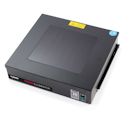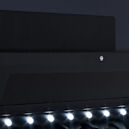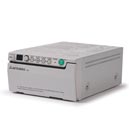- G:BOX Chemi XRQ
- High quantum efficiency (QE) camera
Picogram detection - Multiplex imaging of up to 5 different channels with UV, blue and RGB HI-LED lighting options
Easily switch between blot or gel imaging - Stain-free imaging capability
Capture images of TGX Stain-Free™ FastCast™ acrylamide gels and many more - Auto-exposure
Perfectly exposed chemi images without film - Excellent signal to noise ratio
No annoying backgrounds on your blots - Protocol driven image capture
No camera expertise needed for great results - Motor driven lens and filter wheel
Simple, automated set up - Reproducible and quantifiable data
Accurate results time after time - CFR21 Part 11 compliant
Fully traceable results suitable for regulatory audits - GeneSys application driven image capture software
Contains extensive database of dyes and imaging protocols. All you need to know is the type of gel you’re using and GeneSys automatically selects the optimal lighting and filters to produce the perfect image - GeneTools analysis software (unlimited copies)
Analyse data at your own computer - Blue – Peak 470nm
- Green – Peak 525nm
- Red – Peak 623nm
- IR – Peak 740nm

Cost-efficient chemi imaging and gel doc
For a laboratory that needs hassle-free chemiluminescent detection, as well as routine gel documentation, using the G:BOX Chemi XRQ’s powerful GeneSys software to switch between applications is simplicity itself. Place your chemi blot in, and the system’s cooled camera captures images with a sensitivity equal to film or slide in your gels to generate quality pictures of your DNA and proteins anytime you want.
Featuring a standard darkroom and a 4 million pixel image resolution, the G:BOX Chemi XRQ camera is cooled to provide a low signal to noise ratio with perfect background.
HI-LED lighting options cover the full spectrum of high intensity blue, green, red and infra-red resulting in faster exposure times and publication quality images.
The G:BOX Chemi XRQ is a cost-effective alternative to laser based technology offering a faster workflow for imaging complex multiplex fluorescent gels and blots.
The system is controlled by GeneSys application driven image capture software and comes complete with unlimited copies of GeneTools analysis software.
Gel imaging for fluorescence and chemiluminescence
Specifications
| G:BOX Chemi XRQ | |
|---|---|
| Image resolution (pixels m) | 4 |
| Effective resolution (pixels m) | 16 |
| A/D | 16 bit |
| Greyscales | 65536 |
| Quantum efficiency @ 425nm | 73% |
| Cooling | Peltier |
| Lens (motor driven) | Motor driven zoom 1.2 |
| Filter wheel (7 position motor driven) | Yes |
| UV filter | Yes |
| Use with external PC | Yes |
| Darkroom | |
| Standard | Yes |
| Illumination | |
| Epi LED white lights | Yes |
| Epi UV 302nm | Optional |
| Epi red LED module | Optional |
| Epi blue LED module | Optional |
| Epi green LED module | Optional |
| Epi red LED module M series for multiplexing | Optional |
| Epi green LED module M series for multiplexing | Optional |
| Epi blue LED module M series for multiplexing | Optional |
| Epi IR LED module | Optional |
| IR multiplexing kit (680-800nm) | Optional |
| HI-LED RGB | Optional |
| HI-LED RGBIR | Optional |
| HI-LED RIR | Optional |
| Visible light converter 33 x 31cm | Optional |
| White light pad for visible stains (20 x 14cm) | Optional |
| UltraBright LED blue light transilluminator 20 x 16cm | Optional |
| UV transilluminators | Optional |
| Dimensions | |
| Max image area (cm) | 30.5 x 22.7 |
| Min image area (cm) | 5.1 x 3.8 |
| W x H x D (cm) | 57 x 84 x 45 |
| Weight (kg) | 37 |
| Voltage | 115v/240v |
Accessories

Transilluminators
Syngene offers a range of UV transilluminators suitable for all your imaging needs. Transilluminators are available in 230V 50Hz, 230V 60Hz (-E60), 115V 60Hz (-A), 115V 60Hz (-ACA) and 100V 50/60Hz (-J). Available wavelengths are short wave (254nm, 2020S or 2530S), medium wave (302nm, 2020M or 2530M) and long wave (365nm, 2020L or 2530L).

UltraBright-LED transilluminator
Blue light transilluminators are often used as an alternative to a UV transilluminator when users wish to use ‘safe dyes’ instead of Ethidium Bromide. A blue light transilluminator is a ‘safe’ light source, in that the user is not exposed to harmful UV radiation and samples are free from photonicking. The UltraBright-LED transilluminator can be used instead of the UV transilluminator in all Syngene G:BOX systems.
UltraBright-LED transilluminator can be used with gels up to 20 x 16cm for use in the G:BOX series. This model uses side mounted 470nm LED arrays for illumination.

UV-blue light converter screens
These come in two sizes 21cm x 26cm and 25cm x 30cm and are used to change harmful UV into blue light. They are made of scratch resistant plastic and are easy to retrofit onto a UV transilluminator.

Visible light converter screens
These come in two sizes 30.5cm x 33cm and 23.5cm x 30cm and are used to change UV light into visible light, ideal for imaging Coomassie Blue and Silver Stained gels.

EPI UV
The Epi UV module can be fitted to any G:BOX Chemi darkroom (those produced after July 2010). The module fits above the standard LED white light module which is standard on all G:BOX Chemi systems. The Epi UV module can have either a 254nm, 365nm or 302nm tube. Either one or two modules can be fitted to each darkroom.

Filters
The filter wheel takes the 72mm range of filters.

HI-LEDs
The option to add a full spectrum of high intensity blue, green, red and infra-red HI-LEDs that are up to 200 times brighter than standard LEDs, offering faster exposure times and cost-effective imaging for a wide range of fluorescence gel and blot applications.
The excitation ranges of the HI-LEDs (+/- 10nm)

Printer
Any printer with appropriate Windows drivers can be attached to the G:BOX Chemi. We recommend an A6 thermal printer such as Sony or Mitsubishi. These USB printers will “plug and play” with the G:BOX Chemi and require minimal set up. They will print hard copies of images in under 5 seconds on long life glossy thermal paper to give photographic quality images.
Thermal paper
Available as Matt or Glossy.
UV tubes
Short wave 8W, 254nm, Medium wave 8W, 302nm, Long wave 8W 365nm available.

IQ/OQ/PQ procedures
More and more laboratories require IQ/OQ/PQ verification these days. Syngene’s IQ/OQ/PQ procedures take the user through each step in the verification of a Syngene system in meeting the demands of the laboratory, regulatory compliances and standard operational procedures (SOP). These simple procedures allow the user to verify that a system meets defined installation, quality and performance specifications.
Installation Qualification (IQ)
This verifies that when a system is unpacked it conforms with all purchasing, shipping and unpacking documents. Once this procedure has been followed the system is then ready for the operational check process.
Operational Qualification (OQ)
This procedure establishes if the system meets all the operation and functionality specifications. An operational test is also included at this stage.
Performance Qualification (PQ)
A performance check will establish if the system meets the specification for the nature of the purpose it was intended for. This is verified by using a simple target to establish if the system can meet performance criteria.
Documentation
Each set of IQ/OQ/PQ documents contains a complete set of procedures and checklists for following the verification steps. Included with each ‘pack’ is a simple calibration device (target image) so that the performance of the system can be checked against the PQ requirements. Each set of documents is unique to a particular system and has to be ordered with the system itself. The document pack has full instructions for use and implementation.
Who does this?
Customer – typically a customer can perform these tests by themselves. Their own internal QC department will be familiar with these processes.
Syngene or its distributors
Trained Syngene personnel or trained distributors can also perform the IQ/OQ/PQ procedures, normally at a nominal charge.

